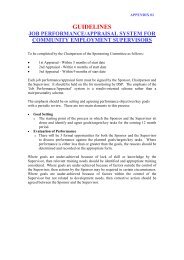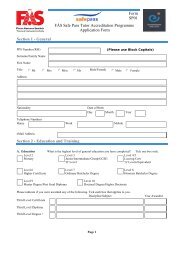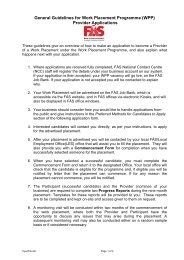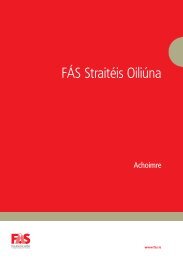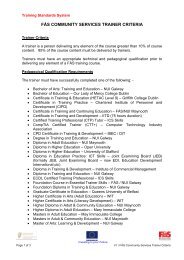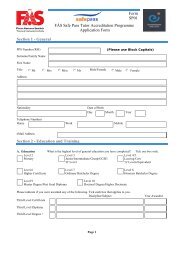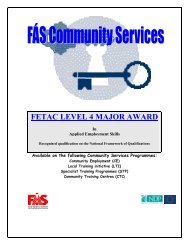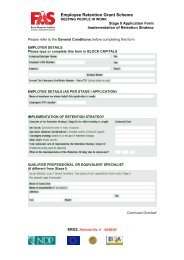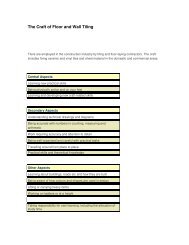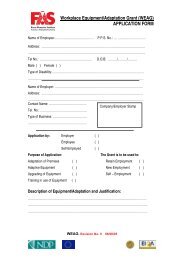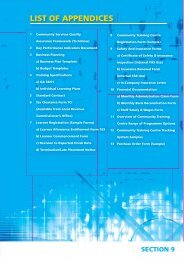Training Specification Standards NO. QA 58/01 - Fás
Training Specification Standards NO. QA 58/01 - Fás
Training Specification Standards NO. QA 58/01 - Fás
You also want an ePaper? Increase the reach of your titles
YUMPU automatically turns print PDFs into web optimized ePapers that Google loves.
FÁS <strong>Training</strong> <strong>Standards</strong><br />
<strong>Training</strong> <strong>Specification</strong><br />
<strong>Standards</strong> <strong>NO</strong>. <strong>QA</strong> <strong>58</strong>/<strong>01</strong><br />
4th Edition<br />
aaaaa<br />
aaaaa aaaaa
Published by<br />
Curriculum and Quality Assurance Department<br />
FÁS — <strong>Training</strong> and Employment Authority<br />
P.O. Box 456<br />
27-33 Upper Baggot Street<br />
Dublin 4<br />
Ireland<br />
© FÁS — Reprinted 2000<br />
All rights reserved. No part of this publication may be reproduced, stored in a retrieval system or<br />
transmitted in any forms or by any means, electronic, mechanical, photocopying, recording or<br />
otherwise, without the prior permission of the copyright owner.
FÁS <strong>Training</strong> <strong>Standards</strong><br />
<strong>Training</strong> <strong>Specification</strong><br />
<strong>Standards</strong> <strong>NO</strong>. <strong>QA</strong> <strong>58</strong>/<strong>01</strong><br />
4th Edition<br />
FÁS — <strong>Training</strong> and Employment Authority
FÁS <strong>Training</strong> <strong>Standards</strong><br />
Introduction<br />
Section 1<br />
This standard is one of a series designed to promote and improve the quality of training.<br />
Prepared and adopted by FÁS, it sets out the basic minimum which should be addressed<br />
when drawing up a <strong>Training</strong> <strong>Specification</strong>.<br />
In designing any training intervention, it is assumed that pre-programme planning namely:<br />
identification of training needs, rationale and cost implications have been considered and<br />
agreed. The next stage in systematic training is to prepare a <strong>Training</strong> <strong>Specification</strong>.<br />
<strong>Training</strong><br />
<strong>Training</strong> includes both directed training and workplace training.<br />
Directed training can be delivered inside or outside the workplace. It consists of planned<br />
and structured training which is insulated from immediate operational job pressures.<br />
Workplace <strong>Training</strong> one the other hand is planned and structured training carried out<br />
under normal operational job pressures.<br />
What is a <strong>Training</strong> <strong>Specification</strong>?<br />
The <strong>Training</strong> <strong>Specification</strong> is a detailed statement of the items to be addressed when<br />
designing any block of training e.g. programme, course, module, unit.<br />
Note that for descriptive purposes, the term “programme” is used throughout this<br />
document. When drawing up a specification, substitute the relevant term, for<br />
example, <strong>Training</strong> Module <strong>Specification</strong> when designing a module of training….<br />
The <strong>Training</strong> <strong>Specification</strong> takes into account such items as training aim, objectives,<br />
approach, equipment/materials to be used, the type of records to be kept, the assessment<br />
and certification system.<br />
Items Covered by this Standard<br />
< <strong>Training</strong> Title & Status<br />
< <strong>Training</strong> Aim<br />
< Programme Objectives<br />
< Outline <strong>Training</strong> Plan<br />
< <strong>Training</strong> Duration<br />
< <strong>Training</strong> Approach<br />
< Record System<br />
< Assessment & Certification System<br />
< Target Trainee Profile<br />
< Trainer/Instructor/Workplace<br />
< Supervisor Profile<br />
< <strong>Training</strong> Facilities<br />
< Review<br />
< Copyright and Acknowledgements<br />
QUALITY ASSURANCE — FÁS <strong>Training</strong> and Employment Authority
FÁS <strong>Training</strong> <strong>Standards</strong><br />
<strong>Training</strong> <strong>Specification</strong>s – The Benefits<br />
The specification is a practical working document to be used by all those involved in developing,<br />
implementing, monitoring and funding training programmes.<br />
As an aid to developing training programmes, the <strong>Training</strong> <strong>Specification</strong>,<br />
< is part of the systematic training process<br />
< aids programme planning<br />
< assist the certification process<br />
< provides a basis for comparison of standards between programmes.<br />
As an aid to implementing training organisation of training programmes, it provides a current<br />
recorded of course characteristics which<br />
< facilitates efficient and effective organisation of training programmes<br />
< ensures continuity i.e. that training programmes are independent of<br />
< designer/instructor<br />
< provides details of resources for related courses.<br />
As and aid to monitoring training programmes, it provides a standard format<br />
< to review programmes<br />
< assure consistency<br />
< assist validation processes.<br />
As an aid to funding training programmes, it<br />
< contains information required by funding agencies<br />
< assists in purchasing and utilization of resources<br />
< provides comparison of programme performance in different locations<br />
QUALITY ASSURANCE — FÁS <strong>Training</strong> and Employment Authority
FÁS <strong>Training</strong> <strong>Standards</strong><br />
Section 2<br />
Standard for <strong>Training</strong> <strong>Specification</strong><br />
To comply with this standard all the items listed must be addressed when drawing up a <strong>Training</strong><br />
<strong>Specification</strong>.<br />
<strong>Training</strong> Title & Status<br />
< The training title should<br />
clearly identify the programme/course/module/unit<br />
be specific to the training content<br />
be included on all written materials produced for the training.<br />
< The status of the <strong>Training</strong> <strong>Specification</strong> should be stated i.e. whether it is at proposal<br />
stage or approved for use. The date (s) set for review (s) of the <strong>Training</strong> <strong>Specification</strong><br />
should be entered.<br />
<strong>Training</strong> Aim<br />
< The rationale for the training i.e. the reasons why the training programme has been<br />
designed should be stated.<br />
< A broad general statement should be included describing the proposed programme and<br />
what it is expected to achieve. It should clearly indicate expected outcomes of the<br />
training in terms of trainee opportunities.<br />
Programme Objectives<br />
< should clearly specify the expected performance to be demonstrated by the trainee at the<br />
end of the overall training period.<br />
< should reflect aim of programme, cover all the proposed skill, knowledge and attitudinal<br />
aspects of the training.<br />
< should be realistic, measurable and unambiguous.<br />
Whereas objectives have three parts (activity, conditions and standards), for the purpose of<br />
producing a <strong>Training</strong> <strong>Specification</strong> only a statement of the activity required i.e. what the<br />
trainee will be able to do on completion of training in terms of knowledge, practical and<br />
personal skills to be demonstrated.<br />
Note: Certification & <strong>Standards</strong>, FÁS, in consultation with industry will identify and agree<br />
relevant national conditions and standards.<br />
QUALITY ASSURANCE — FÁS <strong>Training</strong> and Employment Authority
FÁS <strong>Training</strong> <strong>Standards</strong><br />
Outline <strong>Training</strong> Plan<br />
< should illustrate by means of a diagram<br />
the titles of the modules of training<br />
their sequence of delivery<br />
the balance of time (in days/weeks) allocated to direct and workplace training in each<br />
module as relevant<br />
< should show the content of each module by starting the<br />
Module Title<br />
Module Level<br />
Module Aim<br />
Module Objectives only the activity statements are required for a <strong>Training</strong><br />
<strong>Specification</strong><br />
<strong>Training</strong> Duration<br />
< should indicate the total time allocated to the training in terms of hours per week and<br />
number of weeks. The duration of all main elements including workplace training and<br />
directed training, as appropriate, and the assessment time should be clearly shown.<br />
<strong>Training</strong> Approach<br />
< should clearly identify for directed and workplace training, as appropriate<br />
how the learning will be managed on the training programme<br />
the main training methods<br />
instructional techniques, any special media and audio visual materials to be used.<br />
Record System<br />
< should clearly specify the types of records to be kept for the purposes of<br />
planning and implementing training<br />
showing progress against training plans<br />
assessment and certification<br />
monitoring<br />
administration<br />
QUALITY ASSURANCE — FÁS <strong>Training</strong> and Employment Authority
FÁS <strong>Training</strong> <strong>Standards</strong><br />
Records Systems (cont.)<br />
< should clearly specify the procedures to be applied to ensure records<br />
are kept up-to-date<br />
are maintained in safe-keeping<br />
respect the principle of confidentiality<br />
< should be simple and efficient to administer.<br />
Assessment and Certification System<br />
< Should clearly indicate how the programme is to be assessed for certification purposes<br />
< Should identify<br />
the certifying body<br />
titles, levels and codes of assessment<br />
any endorsements<br />
< Where appropriate should state credits towards other accreditation<br />
< Where locally designed, the assessment system must be in accordance with FÁS<br />
guidelines for Assessing Trainee Attainment.<br />
Target Trainee Profile<br />
< Should be defined as accurately as possible, in accordance with the trainees’ needs and<br />
abilities, with a view to their achieving maximum benefit from course objectives.<br />
< Should include a precise definition of<br />
any required entry level<br />
knowledge / personal / practical skills which trainees should possess before starting<br />
the programme<br />
aptitude and trainability tests<br />
interview requirements<br />
any other selection criteria to be used.<br />
QUALITY ASSURANCE — FÁS <strong>Training</strong> and Employment Authority
FÁS <strong>Training</strong> <strong>Standards</strong><br />
Trainer/Instructor/Workplace Supervisor Profile<br />
< should clearly define the type of trainer/instructor/workplace supervisor required to<br />
develop the skills, knowledge and attitudes necessary for trainees to achieve programme<br />
objectives by stating:<br />
required qualifications, education and training<br />
relevant experience<br />
<strong>Training</strong> Facilities<br />
< should list<br />
capital equipment, non-capital tools and equipment, and consumables required<br />
location specifications for directed and workplace training, as appropriate, to include<br />
workshop and / or classroom requirements<br />
special facilities appropriate to the particular training<br />
Review<br />
< a schedule for review of the nationally approved training specification should outline how<br />
and when the specification will be reviewed to ensure its continued conformance to<br />
industrial and commercial requirements.<br />
Copyright and Acknowledgements<br />
< Reference should be made to:<br />
any special copyright restrictions for materials proposed to be used<br />
people/organisations to be acknowledged.<br />
For further information contact:<br />
Certification and <strong>Standards</strong><br />
QUALITY ASSURANCE — FÁS <strong>Training</strong> and Employment Authority



